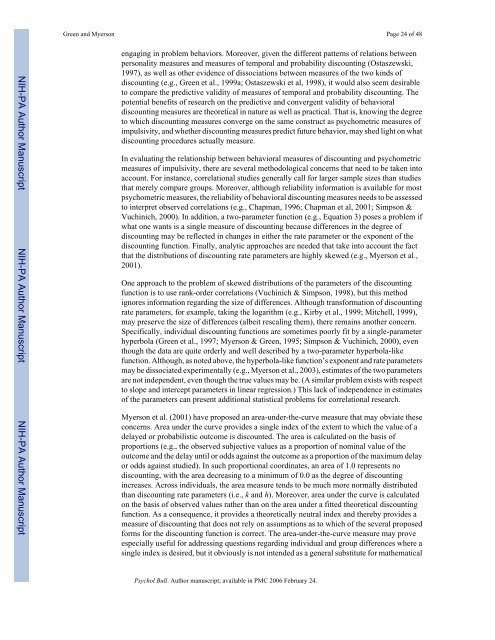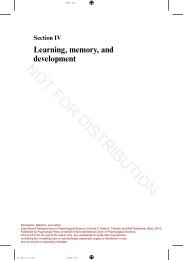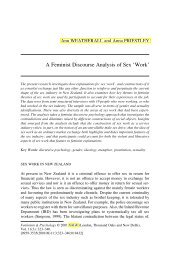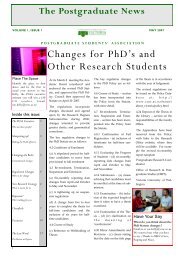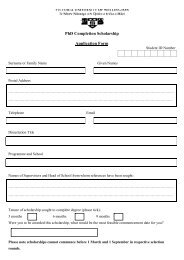green & myerson 2004.. - of /courses
green & myerson 2004.. - of /courses
green & myerson 2004.. - of /courses
You also want an ePaper? Increase the reach of your titles
YUMPU automatically turns print PDFs into web optimized ePapers that Google loves.
Green and Myerson Page 24 <strong>of</strong> 48<br />
NIH-PA Author Manuscript NIH-PA Author Manuscript NIH-PA Author Manuscript<br />
engaging in problem behaviors. Moreover, given the different patterns <strong>of</strong> relations between<br />
personality measures and measures <strong>of</strong> temporal and probability discounting (Ostaszewski,<br />
1997), as well as other evidence <strong>of</strong> dissociations between measures <strong>of</strong> the two kinds <strong>of</strong><br />
discounting (e.g., Green et al., 1999a; Ostaszewski et al, 1998), it would also seem desirable<br />
to compare the predictive validity <strong>of</strong> measures <strong>of</strong> temporal and probability discounting. The<br />
potential benefits <strong>of</strong> research on the predictive and convergent validity <strong>of</strong> behavioral<br />
discounting measures are theoretical in nature as well as practical. That is, knowing the degree<br />
to which discounting measures converge on the same construct as psychometric measures <strong>of</strong><br />
impulsivity, and whether discounting measures predict future behavior, may shed light on what<br />
discounting procedures actually measure.<br />
In evaluating the relationship between behavioral measures <strong>of</strong> discounting and psychometric<br />
measures <strong>of</strong> impulsivity, there are several methodological concerns that need to be taken into<br />
account. For instance, correlational studies generally call for larger sample sizes than studies<br />
that merely compare groups. Moreover, although reliability information is available for most<br />
psychometric measures, the reliability <strong>of</strong> behavioral discounting measures needs to be assessed<br />
to interpret observed correlations (e.g., Chapman, 1996; Chapman et al, 2001; Simpson &<br />
Vuchinich, 2000). In addition, a two-parameter function (e.g., Equation 3) poses a problem if<br />
what one wants is a single measure <strong>of</strong> discounting because differences in the degree <strong>of</strong><br />
discounting may be reflected in changes in either the rate parameter or the exponent <strong>of</strong> the<br />
discounting function. Finally, analytic approaches are needed that take into account the fact<br />
that the distributions <strong>of</strong> discounting rate parameters are highly skewed (e.g., Myerson et al.,<br />
2001).<br />
One approach to the problem <strong>of</strong> skewed distributions <strong>of</strong> the parameters <strong>of</strong> the discounting<br />
function is to use rank-order correlations (Vuchinich & Simpson, 1998), but this method<br />
ignores information regarding the size <strong>of</strong> differences. Although transformation <strong>of</strong> discounting<br />
rate parameters, for example, taking the logarithm (e.g., Kirby et al., 1999; Mitchell, 1999),<br />
may preserve the size <strong>of</strong> differences (albeit rescaling them), there remains another concern.<br />
Specifically, individual discounting functions are sometimes poorly fit by a single-parameter<br />
hyperbola (Green et al., 1997; Myerson & Green, 1995; Simpson & Vuchinich, 2000), even<br />
though the data are quite orderly and well described by a two-parameter hyperbola-like<br />
function. Although, as noted above, the hyperbola-like function’s exponent and rate parameters<br />
may be dissociated experimentally (e.g., Myerson et al., 2003), estimates <strong>of</strong> the two parameters<br />
are not independent, even though the true values may be. (A similar problem exists with respect<br />
to slope and intercept parameters in linear regression.) This lack <strong>of</strong> independence in estimates<br />
<strong>of</strong> the parameters can present additional statistical problems for correlational research.<br />
Myerson et al. (2001) have proposed an area-under-the-curve measure that may obviate these<br />
concerns. Area under the curve provides a single index <strong>of</strong> the extent to which the value <strong>of</strong> a<br />
delayed or probabilistic outcome is discounted. The area is calculated on the basis <strong>of</strong><br />
proportions (e.g., the observed subjective values as a proportion <strong>of</strong> nominal value <strong>of</strong> the<br />
outcome and the delay until or odds against the outcome as a proportion <strong>of</strong> the maximum delay<br />
or odds against studied). In such proportional coordinates, an area <strong>of</strong> 1.0 represents no<br />
discounting, with the area decreasing to a minimum <strong>of</strong> 0.0 as the degree <strong>of</strong> discounting<br />
increases. Across individuals, the area measure tends to be much more normally distributed<br />
than discounting rate parameters (i.e., k and h). Moreover, area under the curve is calculated<br />
on the basis <strong>of</strong> observed values rather than on the area under a fitted theoretical discounting<br />
function. As a consequence, it provides a theoretically neutral index and thereby provides a<br />
measure <strong>of</strong> discounting that does not rely on assumptions as to which <strong>of</strong> the several proposed<br />
forms for the discounting function is correct. The area-under-the-curve measure may prove<br />
especially useful for addressing questions regarding individual and group differences where a<br />
single index is desired, but it obviously is not intended as a general substitute for mathematical<br />
Psychol Bull. Author manuscript; available in PMC 2006 February 24.


